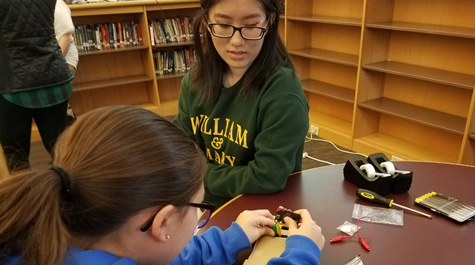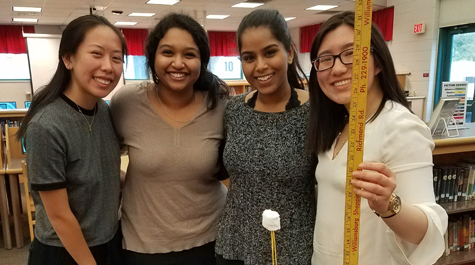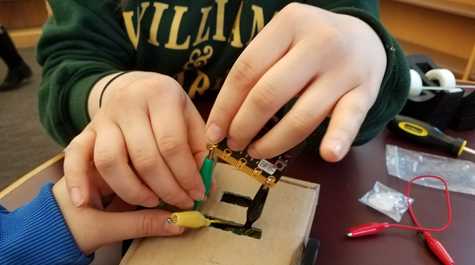W&M computing mentorship for girls wins global service award for second year in a row
William & Mary’s Society of Women in Computing has been on a winning streak. For the second year in a row, the student group has received the Outstanding Community Service Award from the Association for Computing Machinery for their efforts to encourage middle school girls to become involved in computing.
“These young women embody the William & Mary spirit of giving back,” said Evgenia Smirni, S. P. Chockley Professor of Computer Science. “With this award, Computer Science marks with a very high note the end of the celebration of 100 years of co-education at the College.”
The ACM is the world's largest computing society and the primary professional organization for computer scientists. The winners of the ACM Student Chapter Excellence Awards were announced this month and competitors included chapters from around the world.
The Outstanding Community Service Award is given to the ACM student chapter that has made “significant contributions to their communities through one major service project or a series of smaller projects,” according to the award announcement.
William & Mary’s five-member SWC board began crafting weekly lesson plans for a robotics mentorship program with Williamsburg’s Berkeley Middle School in the summer of 2017. They designed coding projects to appeal specifically to girls, from programming Harry Potter-style sorting hats to making music and using microbots to draw shapes.
“It’s unfortunate that the channels through which boys are exposed to computing specifically target their interests, while girls are often an afterthought or completely forgotten,” said Aparna Nagaraj, William & Mary senior and SWC president. “We believe that it is our job to help improve our community by sparking and fostering an interest in computing, because we have the ability while many do not. Through that, we can reach a lot more girls and open doors for them.”
The afterschool program launched in January 2018 with 10 girls enrolled and four SWC mentors. By the following year, the number of participants had grown to 15 girls. The chapter plans to continue to expand the program next year.
The group’s service work was inspired by research suggesting middle school is the most important time to expose girls to programming. Recent research suggests that if middle school girls develop computing experience, they are 18 percent more likely to show interest throughout their high school and college years.
“We realized that starting a mentorship program with the girls at BMS would be a way for us to combine sparking girls’ computing interests in junior high with working with underprivileged students, extending our guidance through high school and beyond,” the group wrote in their award application. “We hope to retain those we mentor and keep in contact with them in the future should they need advice on coursework, career paths, or anything in between.”
The SWC also hosted a computing workshop on campus for students from local schools, including Toano, Lois S. Hornsby and Berkeley Middle Schools and Warhill High School. They also engaged with the larger Williamsburg community by hosting computer help hours at the Williamsburg Regional Library and participated in the library’s STEAM (science, technology, engineering, arts and math) programs for school-aged children.
“The group’s outreach within the College and in the Williamsburg community has been innovative, exemplary and tireless,” Smirni said. "I am incredibly proud of their achievements.”
Since joining William & Mary’s computer science faculty in 1997, Smirni has been part of a coordinated effort to increase female enrollment in the department. Today, women earn just 22 percent of computer science degrees nationwide, a number that has remained stagnant for the past decade.
At William & Mary, there has been a different story. Women are earning computer science degrees at rates well above the national average. In fact, the university’s percentage of female CS master’s graduates was double the national average last year. During the university’s 2017-2018 academic year, a third of all computer science degrees went to women. Half of all graduating CS minors were women.
“There’s so much speculation as to why the gender gap exists and persists,” said Nagaraj. “I think at its core, the problem is just that girls don’t have much exposure to computing during their formative years. My hope is that SWC will establish a stronger presence on campus and in the community to create a social culture and network in computer science, especially as the department continues to grow at an incredible pace.”
William & Mary recently joined a statewide effort to increase the number of Virginians earning computer science and related degrees. The Tech Talent initiative challenges Virginia colleges and universities to produce an additional 25,000 computer science-related degree holders by 2039.
William & Mary’s Board of Visitors approved a resolution last month to join the statewide incentive with a stated goal to increase the number of undergraduate computer science degrees from 70 to at least 160 per year. The resolution also says the university will establish a new professional master’s degree in computer science, eventually generating at least 35 degrees per year.
“Having the skills to be in computing opens up a world of opportunity,” said Nagaraj. “Those skills are in demand in every industry and can really take you where you want to go.”
 Skip to main content
Skip to main content



